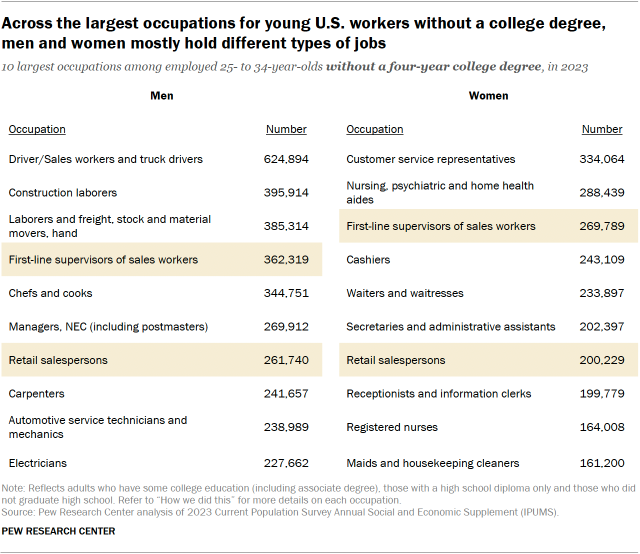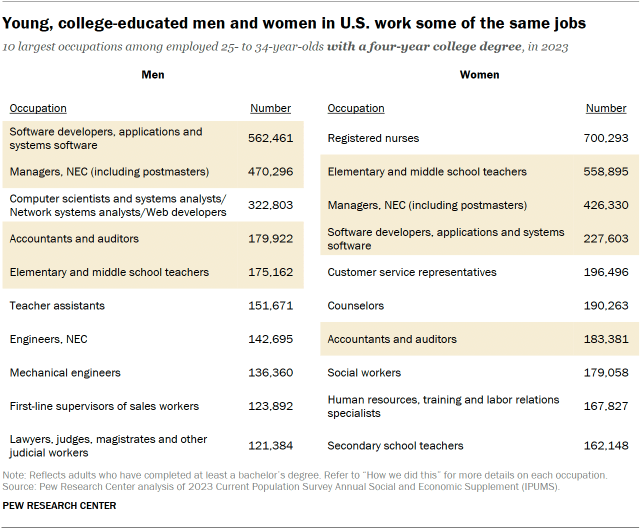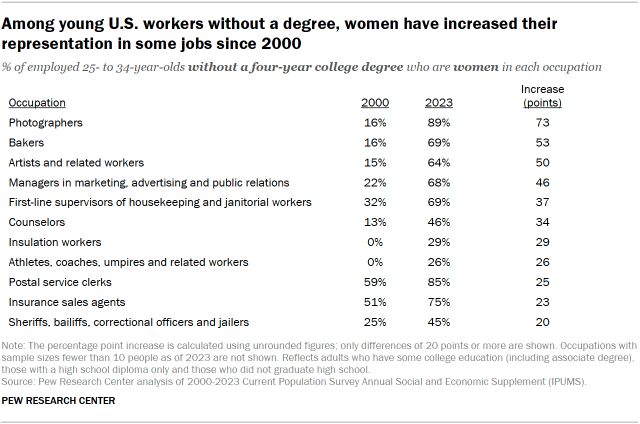


In the United States, young men and women who have a four-year college degree often work in some of the same professions. But there is considerably less professional overlap among young men and women without a college degree, according to a new Pew Research Center analysis of government data.
Pew Research Center conducted this analysis to learn more about how young women and men are represented across occupations and how representation differs by education.
This analysis of the gender composition of the occupations held by young workers is derived from the Current Population Survey (CPS). Administered jointly by the U.S. Census Bureau and the Bureau of Labor Statistics, the CPS is a monthly survey of approximately 60,000 occupied households that typically interviews about 50,000 households. It is the source of the nation’s official statistics on unemployment and is explicitly designed to survey the labor force. It is representative of the civilian, noninstitutionalized population.
This analysis used the Annual Social and Economic Supplement (ASEC) of the CPS, conducted in March of each year. The ASEC survey typically features an expanded sample of more than 75,000 households with about 70,000 interviews. The ASEC collected in 2023 had about 57,000 households. The ASEC is the basis for the Census Bureau’s annual income and poverty reports.
The CPS microdata used in this report are the Integrated Public Use Microdata Series (IPUMS) provided by the University of Minnesota. The IPUMS assigns uniform codes, to the extent possible, to data collected in the CPS over the years. Read more information about the IPUMS, including variable definition and sampling error. Refer to the CPS coding scheme for more details on each occupation.
Young women without a college degree are highly concentrated in a few job types, including customer service representatives, nursing and home health aides, and first-line supervisors of sales workers, as of 2023. By contrast, the top three occupations for young men without a college degree are driver/sales workers and truck drivers, construction laborers, and freight and material movers.

This mismatch in the jobs men and women hold is often referred to as “occupational segregation,” and there is more of it among young workers without a bachelor’s degree than there is among those with a college education.
Looking at the 10 largest occupations held by young men and women without a college degree, there are two in common. Large numbers in each group are employed as retail salespersons and first-line supervisors of sales workers. Otherwise, the largest occupations of noncollege young men and women are different.
These workers can share the same workplace and be doing different tasks. At a restaurant, for example, young women without a college degree are more likely to be working as waitresses, while young men without a degree are more likely to be working as chefs or cooks.
There’s less gender segregation across the 10 most common occupations for young workers with at least a bachelor’s degree. In this group, large numbers of both men and women work in four of the top occupations: software developers, managers, accountants and auditors, and elementary and middle school teachers.
Still, the largest number of college-educated young women work as registered nurses, an occupation that isn’t even in the top 10 for college-educated young men. And large numbers of college-educated men – but not women – work as computer scientists or systems analysts/web developers.

While looking at the top 10 occupations gives us a window into gender differences in the workplace, it doesn’t show the whole picture. Federal occupational data identifies over 430 detailed occupations, ranging from “Managers, NEC (including postmasters)” to “Meter readers, utilities.”
Researchers have summarized gender differences across all of these detailed occupations by creating an index of segregation. The index ranges from 0 to 100 and shows what share of men or women would have to change occupations for both to be equally represented across all occupations. A value of 0 implies that women and men work in the same jobs. A value of 100 implies complete segregation – in other words, that there are no occupations in which both men and women work.
In 2023, the segregation index value across all occupations was lower for young workers with a college degree (value of 41) than among workers without a degree (value of 55).
Prior research has shown that occupational segregation has declined since 1970 and that college-educated women in particular have experienced the largest decline. Since 2000, however, there has been more of a decline in occupational segregation among young women without a college degree.

The decline in segregation among young women without a college degree partly reflects their growing presence in specific occupations.
In 2023, women accounted for 22% of young painters without a degree, up from 3% in 2000. And women account for 68% of young managers without a degree in marketing, advertising and public relations, up from 22% in 2000.